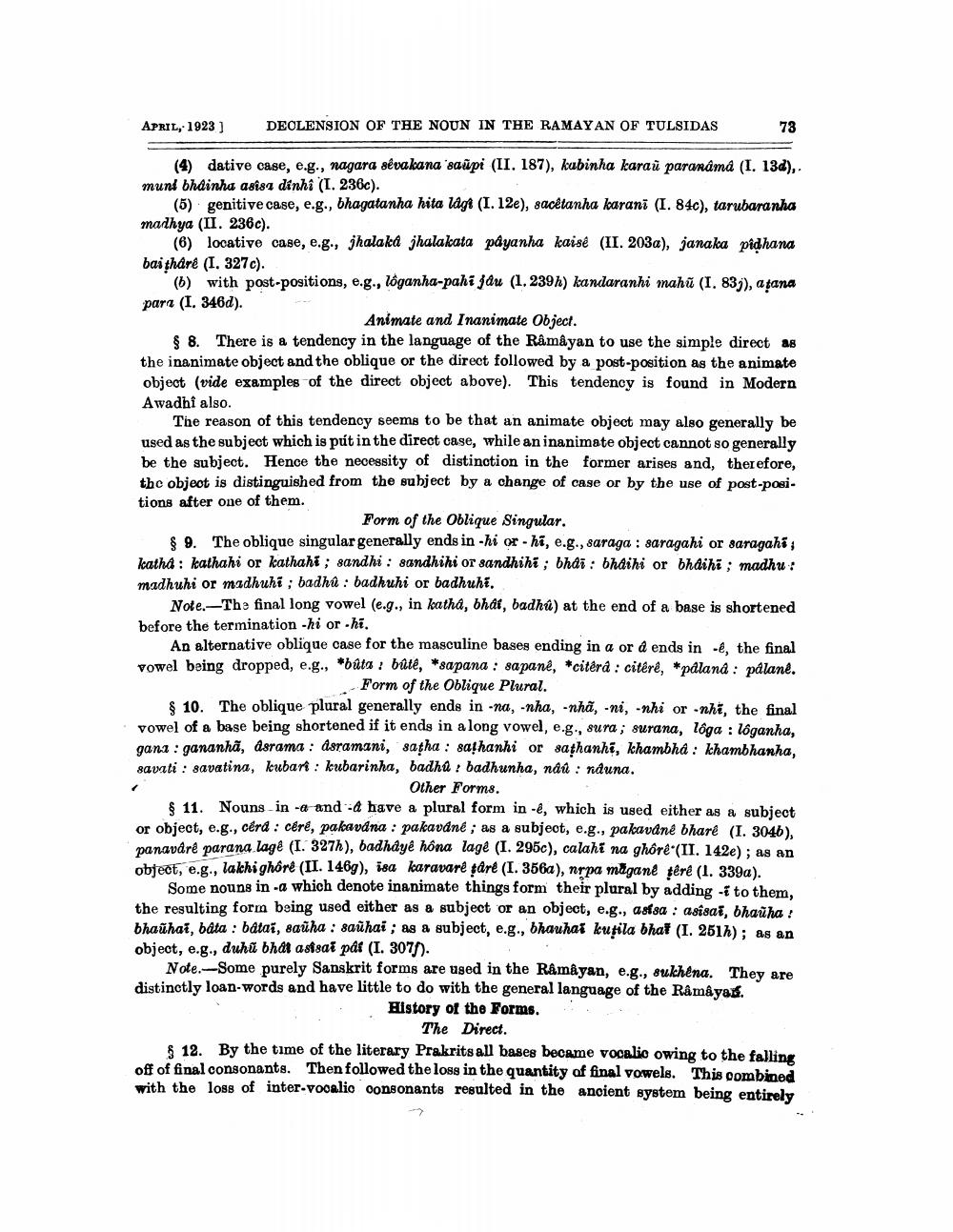________________
APRIL, 1923]
DECLENSION OF THE NOUN IN THE RAMAYAN OF TULSIDAS
73
(4) dative case, e.g., nagara sêvakana saupi (II. 187), kabinha karaŭ paranâmâ (I. 13d),. muni bhdinha asisa dinhi (I. 236c).
(5) genitive case, e.g., bhagatanha hita lågt (I. 12e), sacêtanha karani (I. 84c), tarubaranha madhya (II. 236c).
(6) locative case, e.g., jhalaká jhalakata pâyanha kaisé (II. 203a), janaka piḍhana baisharé (1.327e).
(b) with post-positions, e.g., loganha-pahi jâu (1.239h) kandaranhi mahữ (I. 83j), aṭana para (I. 346d).
Animate and Inanimate object.
§ 8. There is a tendency in the language of the Râmâyan to use the simple direct as the inanimate object and the oblique or the direct followed by a post-position as the animate object (vide examples of the direct object above). This tendency is found in Modern Awadhi also.
The reason of this tendency seems to be that an animate object may also generally be used as the subject which is put in the direct case, while an inanimate object cannot so generally be the subject. Hence the necessity of distinction in the former arises and, therefore, the object is distinguished from the subject by a change of case or by the use of post-positions after one of them.
Form of the Oblique Singular.
§ 9. The oblique singular generally ends in -hi or-hi, e.g., saraga: saragahi or saragahi; katha: kathahi or kathahi; sandhi: sandhihi or sandhihi; bhâĩ: bhâihi or bhdihĩ; madhu : madhuhi or madhuhi; badhû badhuhi or badhuhi.
Note. The final long vowel (e.g., in katha, bhai, badhu) at the end of a base is shortened before the termination -hi or -hi.
An alternative oblique case for the masculine bases ending in a or å ends in -e, the final vowel being dropped, e.g., *bûta: bûte, *sapana: sapanê, *citêrâ: citêrê, *pálaná: pâlane. Form of the Oblique Plural.
§ 10. The oblique plural generally ends in -na, -nha, nhã, -ni, nhi or -nhi, the final vowel of a base being shortened if it ends in a long vowel, e.g., sura; surana, lôga: loganha, gana gananhã, asrama: asramani, satha: sathanhi or sathanh, khambha: khambhanha, savati: savatina, kubari kubarinha, badhû badhunha, nâu: nduna.
Other Forms.
§ 11. Nouns in -a and -a have a plural form in -ê, which is used either as a subject or object, e.g., cerá: céré, pakavana: pakaváné; as a subject, e.g., pakavané bharê (I. 3046), panavâre parana lagê (I. 327h), badhayê hôna lagê (I. 295c), calahi na ghôrê (II. 142e); as an object, e.g., lakhighôre (II. 146g), isa karavarê târé (I. 356a), nṛpa maganê têrê (1. 339a).
Some nouns in -a which denote inanimate things form their plural by adding - to them, the resulting form being used either as a subject or an object, e.g., assa: asisai, bhauha bhauhai, bâta: bâtai, sauha: sauhai; as a subject, e.g., bhauhar kutila bhak (I. 251h); as an object, e.g., duhu bhat asssai pat (I. 307).
Note. Some purely Sanskrit forms are used in the Râmâyan, e.g., sukhena. They are distinctly loan-words and have little to do with the general language of the Râmâyan.
History of the Forms.
The Direct.
§ 12. By the time of the literary Prakrits all bases became vocalic owing to the falling off of final consonants. Then followed the loss in the quantity of final vowels. This combined with the loss of inter-vocalic consonants resulted in the ancient system being entirely




